AVADirect Clevo P170EM: Has AMD’s HD 7970M Got Game?
by Jarred Walton on October 2, 2012 1:35 PM ESTClevo P170EM 7970M Gaming Performance
We’re looking at over $2000 worth of gaming notebook here, so there’s not much point in bothering with the Value gaming charts—though you can find them in Mobile Bench if you’re interested. As we noted earlier, we have several driver versions that we’ve tested. First, there’s the initial driver dating back to May 2012 in red; we had a couple crashes to desktop with this driver (specifically in Batman and DiRT 3), and overall performance at lower settings is less than stellar with GPU underutilization issues clearly present. Next we have the recently released Catalyst 12.9 Beta in dark green, but that driver is mostly focused on separating the AMD driver updates from Intel driver updates and GPU underutilization is still a concern. Finally, we have a hotfix driver building off the 12.9 Beta that AMD hopes to have available for the public in the next week.
We’re seeing clear improvements with the Hotfix for many titles, with some games showing improvements of 50% or more at lower detail settings. I’m still not certain AMD has completely fixed the GPU underutilization issues, and there are at least a couple titles where performance at certain settings has decreased slightly relative to the initial drivers, but the improvements seen in the 12.9 hotfix preview driver give us hope that they’ll get things sorted out. At present, the hotfix driver is undergoing testing and packaging preparation (e.g. our test driver came with a bunch of extra files and required booting into safe mode to replace a couple of DX9 DLLs before it was fully functional). Once AMD is done with their testing and packaging, though, the driver installation process should be the same as a normal AMD Radeon driver.
We’ll start with our “Mainstream” settings, which are more likely to see GPU underutilization since they’re not as demanding, and then we’ll look at Enthusiast performance. After that we’ll have a closer inspection of the various drivers and how performance has changed. We have Alienware’s M17x R4 with a GTX 680M in our charts, but we’ll have a more detailed look at GTX 680M vs. HD 7970M performance when we get to part 2 of the P170EM review, as we’re throwing a bunch of other recent releases at the two notebooks to see how they fare on a wider selection of benchmarks.
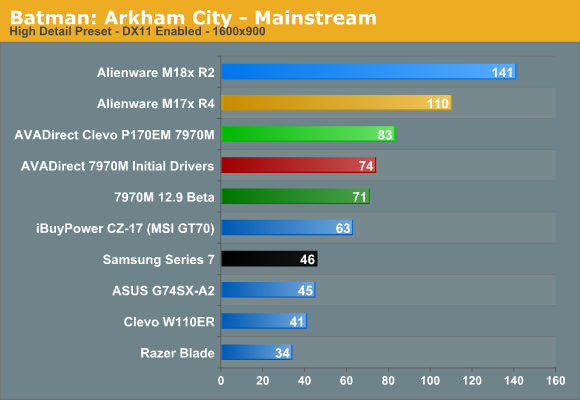
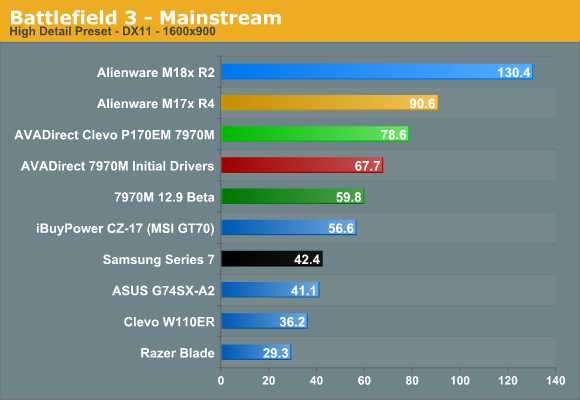
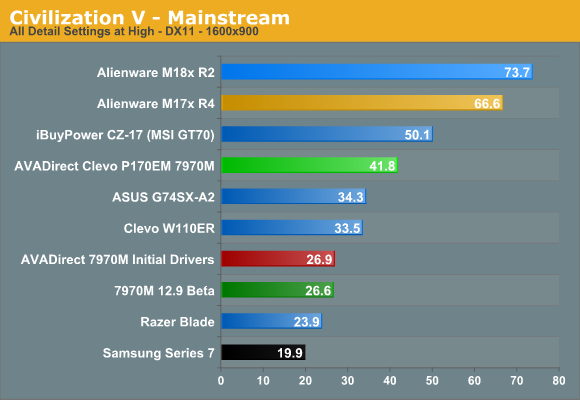

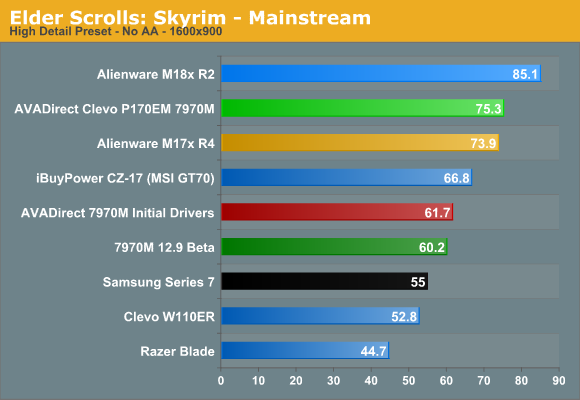
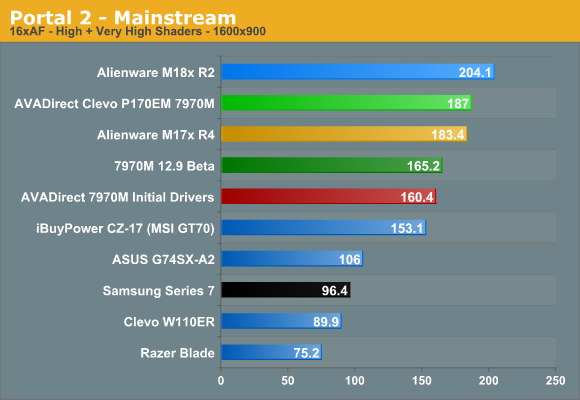
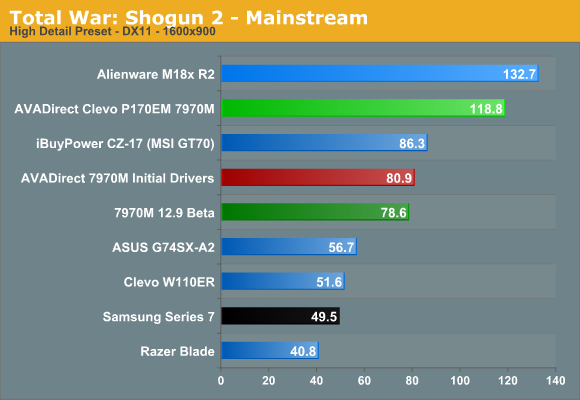
At our Mainstream settings (which are actually quite demanding), the 7970M acquits itself quite well—at least with the Hotfix driver. AMD consistently places third in our charts, behind the GTX 680M and 680M SLI—and the latter isn’t really a fair comparison. There are even a couple titles (Portal 2 and Skyrim) where AMD takes a slight lead over NVIDIA, though we’re looking at two different laptops. In terms of percentages, just to spoil Part 2 where we’ll look at the P170EM with GTX 680M, NVIDIA does sweep the Mainstream settings on P170EM. The lead ranges from as little as 2% in Shogun 2 to 55% in Civilization V, with an average performance lead of 14%.
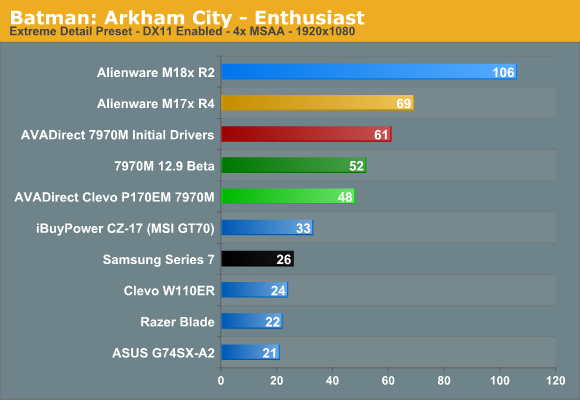
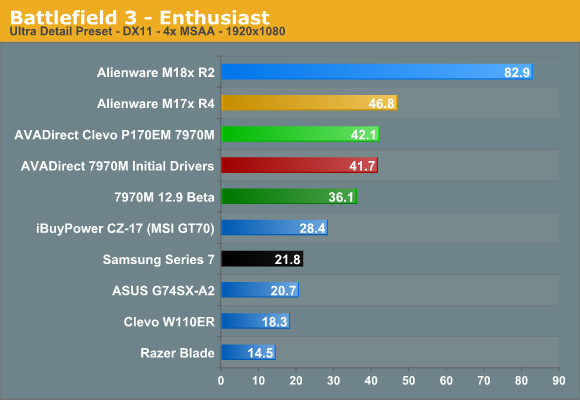
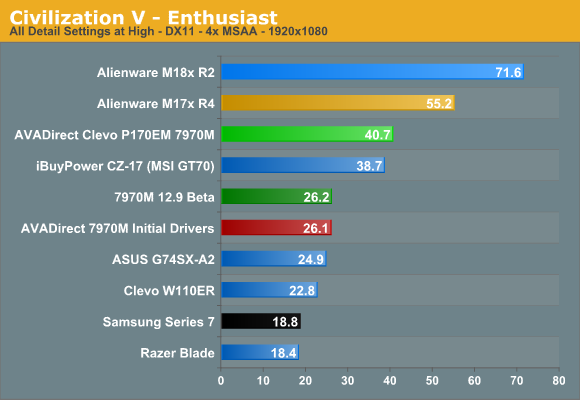
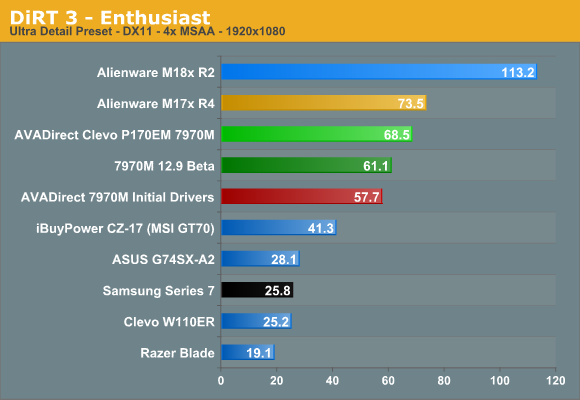
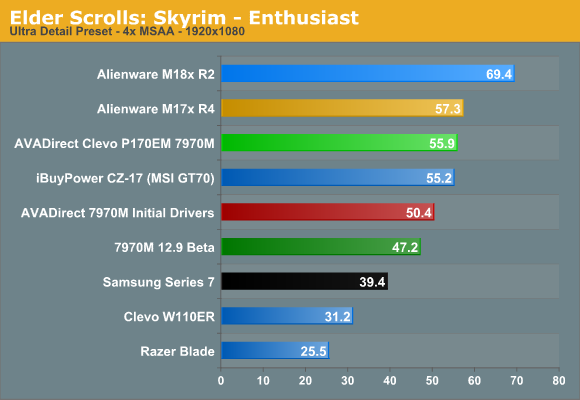
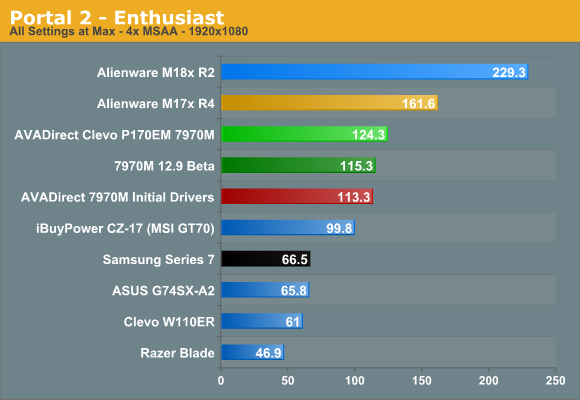
Our Enthusiast settings are what most people considering the P170EM are going to focus on, since it comes with a 1080p display and costs a pretty penny. Things are a bit different this time, as the Hotfix actually offers the worst performance out of the three drivers tested in Batman. Other than that one title, however, the Hotfix continues to be the fastest Enduro 7970M driver we’ve tested. All of the games we tested are still very playable at >40 FPS, though Shogun 2 won’t let us use the “Very High” settings. Looking at the NVIDIA comparison (and again using my non-yet-published results), the 7970M is actually tied with the 680M in DiRT 3 and Battlefield 3, while NVIDIA maintains a healthy 30-35% performance lead in Batman, Civilization V, and Portal 2. Overall, NVIDIA nets a 20% average performance advantage over the six titles we tested at our maximum settings; we’ll revisit this topic again with additional games next week.










61 Comments
View All Comments
extide - Tuesday, October 2, 2012 - link
I am fairly sure it is a single link DVI, not Dual Link. Did you actually test a 2560 res screen on the DVI port?JarredWalton - Tuesday, October 2, 2012 - link
Argh! Why, Clevo, WHY!? They supported dual-link DVI for so long, and it's literally a cost savings of pennies these days. But you're right: it's single-link only (my 30" LCD only allows 1280x800 when connected). Consider me flogged, and I've updated the text.Freakie - Tuesday, October 2, 2012 - link
Really? That sure does look like a DVI-I Dual Link connector on the back though, which means it *should* pinned for Dual-Link, right?. Do you think that it might be a driver issue with AMD?Freakie - Tuesday, October 2, 2012 - link
Nevermind, just looked at the specs on Sager's version and yeah, DVI-I Single Link... man does that suck some serious balls.Penti - Wednesday, October 3, 2012 - link
At least it has DisplayPort, but it only makes me view these gaming notebooks in even worse light. DP is fine and should be brought forward as the connector for high-res screens but then why keep a DVI? Does it support dual screens? Then why not two DPs and ship a passive DP>VGA/DVI adaptor and an HDMI-adaptor with the kit. Use DP everywhere or keep your DVI-DL I say. Most people doesn't really think about the connectivity but with the amount of people with 27 and 30-inch monitors around it should be a bigger issue and you shouldn't have to buy high-end or business class stuff to get the possibility to use DP or DVI-DL as it is now, consumer stuff generally doesn't have it.Roland00Address - Tuesday, October 2, 2012 - link
That makes me pretty angry why would you be so stupid with cost cutting.mczak - Wednesday, October 3, 2012 - link
FWIW that's not really Clevo's problem but intel's. intel's chipset do simply not support dual-link dvi (the only way to get higher than 1920x1200 resolution with them is with DisplayPort), so with Enduro (and Optimus for that matter) when displays are always connected to the IGP it simply can't work.Well there would be some possible solutions to that problem but neither one is great:
1) connect dvi directly to discrete gpu. This means whenever you want to use external monitor you'll need to switch to the discrete gpu. I know in the past some notebooks were wired like that, but I believe this is incompatible with enduro/optimus (in theory it should be possible to only use the copy-to-igp approach for one display but not for all but probably not in practice), hence you'd also need muxes for switching all other displays.
2) the notebook could use additional dual-link tmds chip. intel's chipset still support svdo, and it should be possible to add a dual-link capabable svdo to dvi converter chip. But costs will be higher than a few pennies.
I don't know about notebooks but I've not seen a single desktop motherboard with 60- or 70-series intel chipset doing that - you NEED displayport for higher resolution (and unfortunately most budget motherboards skip DP).
JarredWalton - Wednesday, October 3, 2012 - link
Oh, true! I didn't even think about that aspect. It's silly that Intel supports higher resolutions with DP than with DVI, though.mczak - Wednesday, October 3, 2012 - link
Well I'm not sure it's totally silly. Don't forget AMD is heading in the same direction - apparently dual-link tmds transmitters don't come for free, every AMD gpu (since Northern Islands) only supports one dual-link dvi port even if they still support otherwise simultaneous use of two dvi/hdmi ports - you've got two high res monitors (at least) one is going to use DP.Near all monitors (save some Korean imports) supporting such resolutions though support DP however nowadays, so it isn't that bad as long as you've got a DP port on the graphic card side (and my advice would be to stay far away from high res monitors not featuring DP - too bad though if you already have such a monitor since certainly earlier models did not support DP).
crfog - Tuesday, October 2, 2012 - link
First off: I'm a Clevo P170EM owner.Though I don't have time to read the entire article right now, I got as far as the keyboard review and saw some errors regarding the back-lighting. If you look to the top right hand corner of the numpad, you'll see four keys with odd secondary symbols on them. Pressing the Fn key plus these will get you the following: either quick access to the back-lighting settings (which, unfortunately as an application doesn't seem to have an easy way to close), an on-off setting (much easier than setting the colour to black as you stated), and brightness settings.
Hopefully, I'll have time to read the rest of the article tonight.